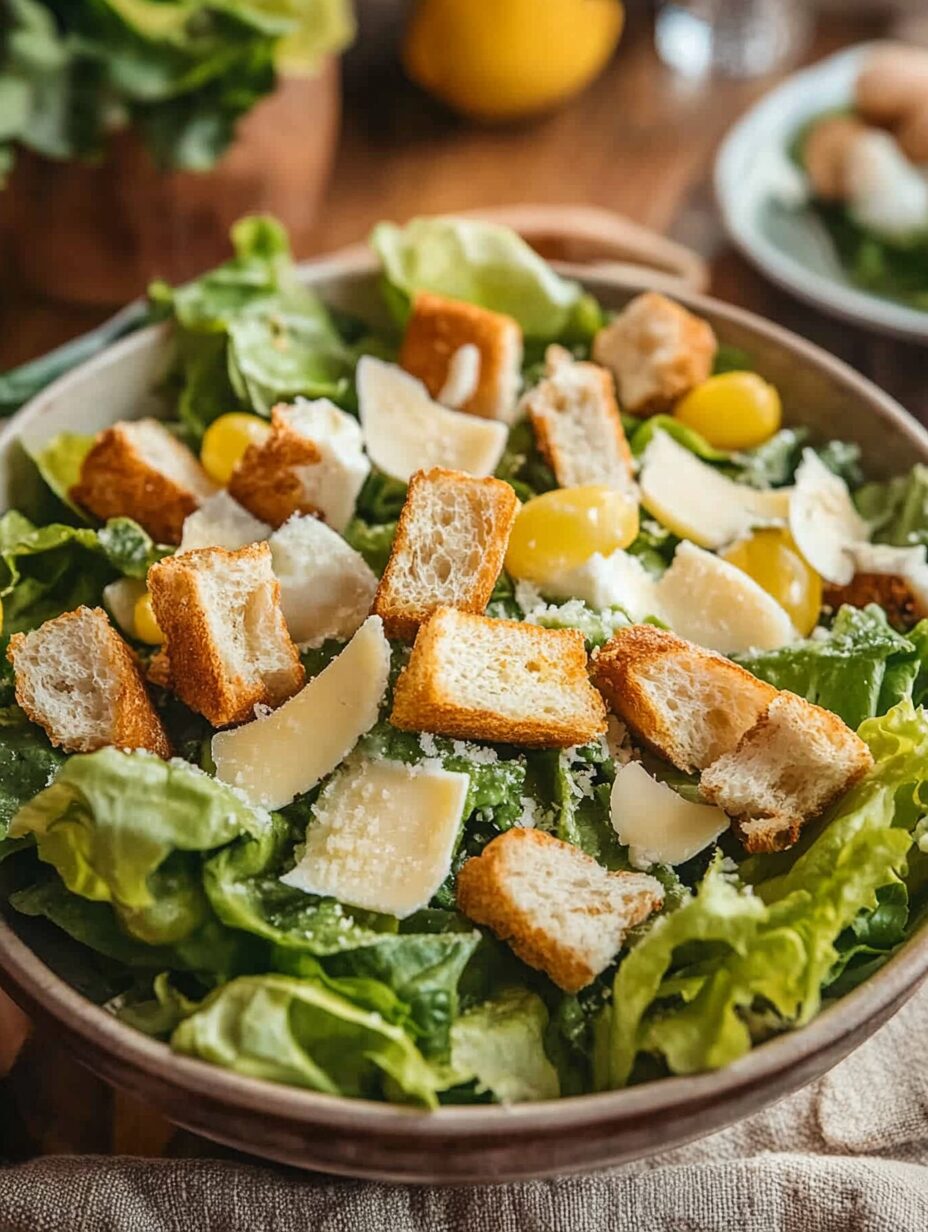When it comes to timeless salads, nothing beats the elegance and simplicity of the Classic Caesar Salad. With its crisp romaine lettuce, crunchy croutons, sharp Parmesan cheese, and creamy, tangy dressing, this iconic dish has won over hearts and palates worldwide. But what exactly makes a Caesar salad “classic,” and how can you master it at home? In this ultimate guide, we’ll take a deep dive into every aspect of creating the perfect Caesar Salad—from selecting the freshest ingredients to making the dressing from scratch and exploring delicious variations.
A Brief History of the Classic Caesar Salad
Before we dive into the how-to, let’s take a step back to appreciate the roots of the Classic Caesar Salad. Contrary to popular belief, it wasn’t born in Italy. The Caesar Salad was invented in 1924 by Italian-American restaurateur Caesar Cardini in Tijuana, Mexico. Legend has it that he threw together what ingredients he had on hand during a busy Fourth of July rush. The result? A salad that quickly became an international staple.
Why the Classic Caesar Salad Remains Timeless
The Classic Caesar Salad has endured for a reason. It balances textures and flavors beautifully—crunchy lettuce, creamy dressing, umami-rich Parmesan, and garlicky croutons. Whether served as a side or a standalone meal with added protein, it’s a dish that always feels satisfying and elegant.
Essential Ingredients for a Classic Caesar Salad
Crafting a perfect Classic Caesar Salad starts with choosing high-quality ingredients. Here’s what you’ll need:
- 1 large head of romaine lettuce (or 2 small heads), washed and dried
- 1 cup homemade or store-bought croutons
- ¼ cup freshly grated Parmesan cheese
For the Classic Caesar Dressing:
- 1 egg yolk (or 1 tablespoon mayonnaise if avoiding raw egg)
- 1 teaspoon Dijon mustard
- 2 tablespoons fresh lemon juice
- 1 teaspoon Worcestershire sauce
- 1 clove garlic, minced or grated
- 2 anchovy fillets, mashed (or 1 teaspoon anchovy paste)
- ½ cup extra virgin olive oil
- Freshly ground black pepper to taste
- Salt, to taste
Step-by-Step: How to Make Classic Caesar Dressing
The dressing is what sets the Classic Caesar Salad apart. Here’s how to make it from scratch:
- In a medium bowl, whisk together the egg yolk, Dijon mustard, lemon juice, Worcestershire sauce, garlic, and anchovy paste until smooth.
- Slowly drizzle in olive oil while whisking continuously to create an emulsion.
- Season with salt and pepper to taste.
Alternatively, use a blender or food processor for quicker emulsification.
Crafting the Perfect Croutons
Croutons might seem like an afterthought, but in a Classic Caesar Salad, they play a vital role. Homemade croutons are leagues better than store-bought.
Homemade Croutons Recipe:
- 2 cups cubed day-old bread (baguette or sourdough preferred)
- 2 tablespoons olive oil
- 1 clove garlic, minced
- Salt and pepper to taste
Instructions:
- Preheat oven to 375°F (190°C).
- Toss bread cubes with olive oil, garlic, salt, and pepper.
- Spread on a baking sheet and bake for 10-15 minutes until golden and crispy.
Assembling Your Classic Caesar Salad
Once all the components are ready, assembling the Classic Caesar Salad is a breeze:
- Tear the romaine lettuce into bite-sized pieces and place in a large salad bowl.
- Drizzle with the prepared Caesar dressing and toss gently to coat evenly.
- Add croutons and grated Parmesan.
- Toss again lightly and serve immediately.

Adding Proteins: Make It a Meal
The Classic Caesar Salad is incredibly versatile. Add a protein source to transform it from a side dish into a hearty main course:
- Grilled Chicken: Classic combo with lemon-marinated chicken breast.
- Shrimp: Garlic-grilled shrimp adds a coastal twist.
- Salmon: Seared or smoked salmon brings richness.
- Steak: For a robust and filling option.
- Crispy Tofu: For a vegetarian-friendly protein punch.
Tips for the Best Classic Caesar Salad
- Use Fresh, Crisp Lettuce: Romaine hearts give the best crunch.
- Dry the Lettuce Thoroughly: Water dilutes the dressing and ruins texture.
- Serve Cold: Chill the lettuce and dressing for a refreshing experience.
- Use Real Parmesan: Grate it fresh for maximum flavor.
- Don’t Overdress: Add dressing gradually to avoid a soggy salad.
Common Caesar Salad Mistakes to Avoid
- Using bottled dressing: It often lacks the tangy richness of homemade.
- Skipping anchovies: They add umami and depth—don’t leave them out!
- Using limp lettuce: Always use fresh, crisp leaves.
- Neglecting balance: Adjust lemon, garlic, and anchovy to your taste.
Variations on the Classic Caesar Salad
While purists might prefer the original, here are some popular spins on the classic:
- Kale Caesar: Substitute kale for romaine (massage first to soften).
- Vegan Caesar: Use vegan mayo, capers instead of anchovies, and nutritional yeast in place of Parmesan.
- Spicy Caesar: Add chili flakes or hot sauce to the dressing.
- Caesar Pasta Salad: Toss cooked pasta with dressing, lettuce, and toppings.
The Nutritional Value of a Classic Caesar Salad
A traditional Classic Caesar Salad offers a decent balance of fats, protein, and fiber (especially with added protein). However, it can be high in calories and sodium, depending on dressing and toppings.
To lighten it up:
- Use Greek yogurt or avocado as a base for the dressing.
- Reduce cheese and crouton quantity.
- Skip processed ingredients.
Storing and Making Ahead
Dressing: Store in an airtight container in the fridge for up to 5 days. Shake before using.
Croutons: Keep in a sealed container at room temperature for up to 1 week.
Assembled Salad: Best eaten fresh. If making ahead, store components separately and toss just before serving.
Classic Caesar Salad FAQs
1. Is it safe to use raw egg yolk in Caesar dressing? Yes, if using pasteurized eggs. Otherwise, use mayonnaise as a safer alternative.
2. Can I make Caesar Salad without anchovies? Yes, but it will lack the traditional umami depth. Consider using capers as a substitute.
3. What can I use instead of romaine lettuce? Kale, arugula, or mixed greens work well, but the texture will differ.
4. How long does Caesar dressing last? Homemade dressing lasts 3-5 days in the refrigerator.
5. Is Caesar Salad gluten-free? It can be if you use gluten-free bread for croutons and check the Worcestershire sauce.
6. Can I freeze Caesar dressing? Not recommended. The emulsion may break when thawed.
7. What wine pairs well with Caesar Salad? Try a crisp white like Sauvignon Blanc or a light Pinot Grigio.
8. How do restaurants make their Caesar Salad so creamy? They often use more egg yolk or mayonnaise and blend the dressing thoroughly.
9. What’s the best bread for croutons? Day-old French baguette or sourdough works best.
10. Can I add fruit to Caesar Salad? Not traditional, but grilled peaches or apple slices can add a fun twist.
Conclusion: The Art of the Classic Caesar Salad
Creating the Classic Caesar Salad is about more than just tossing lettuce and dressing. It’s about attention to detail, quality ingredients, and balance. From the umami-rich dressing to the crispy homemade croutons and the crunchy freshness of romaine lettuce, every bite should feel like a celebration. Whether you’re serving it at a dinner party, enjoying it as a quick lunch, or turning it into a protein-packed main, the Classic Caesar Salad never goes out of style. Now that you’re armed with all the tips, tricks, and variations, it’s time to make your own perfect Caesar masterpiece!
Print
The Ultimate Guide to Crafting the Classic Caesar Salad
- Total Time: 25 minutes
- Yield: 4 servings
Description
Master the art of the Classic Caesar Salad with this detailed guide—fresh, creamy, and packed with bold, savory flavor.
Ingredients
Pour la salade:
1 grande tête de laitue romaine (ou 2 petites), lavée et séchée
1 tasse de croûtons faits maison ou du commerce
1/4 tasse de Parmesan fraîchement râpé
Pour la sauce Caesar maison:
1 jaune d’œuf (ou 1 c. à soupe de mayonnaise)
1 c. à café de moutarde de Dijon
2 c. à soupe de jus de citron frais
1 c. à café de sauce Worcestershire
1 gousse d’ail, râpée ou hachée
2 filets d’anchois (ou 1 c. à café de pâte d’anchois)
1/2 tasse d’huile d’olive extra vierge
Sel et poivre noir fraîchement moulu
Pour les croûtons maison (optionnel) :
2 tasses de pain rassis en cubes
2 c. à soupe d’huile d’olive
1 gousse d’ail émincée
Sel et poivre
Instructions
-
Préparer la sauce :
Fouetter le jaune d’œuf, la moutarde, le jus de citron, la sauce Worcestershire, l’ail et les anchois. Ajouter l’huile en filet tout en fouettant pour créer une émulsion. Saler et poivrer selon votre goût. -
Préparer les croûtons :
Mélanger les cubes de pain avec l’huile, l’ail, le sel et le poivre. Cuire au four à 190°C (375°F) pendant 10–15 minutes jusqu’à ce qu’ils soient dorés et croustillants.
-
Assembler la salade :
Déchirer la laitue en morceaux. Ajouter la sauce et bien mélanger. Ajouter les croûtons et le parmesan. Mélanger à nouveau légèrement.
Notes
-
Séchez bien la laitue pour éviter de diluer la sauce.
-
Utilisez des ingrédients frais pour un goût optimal.
-
Ne surchargez pas en sauce – ajoutez-en petit à petit.
-
Le parmesan fraîchement râpé est bien meilleur que le fromage pré-râpé.
-
Servez immédiatement pour garder le croquant des croûtons et de la laitue.
- Prep Time: 15 minutes
- Cook Time: 10 minutes (pour les croûtons)


